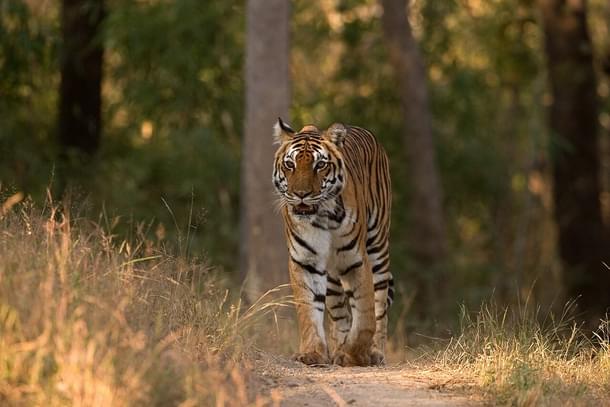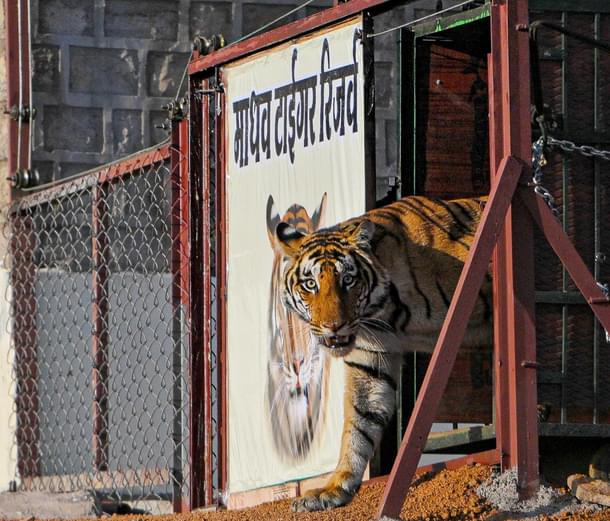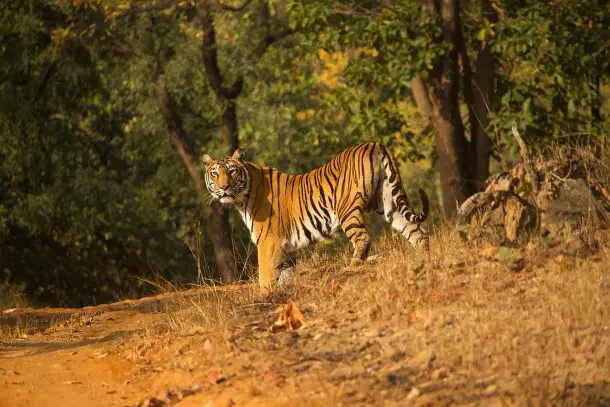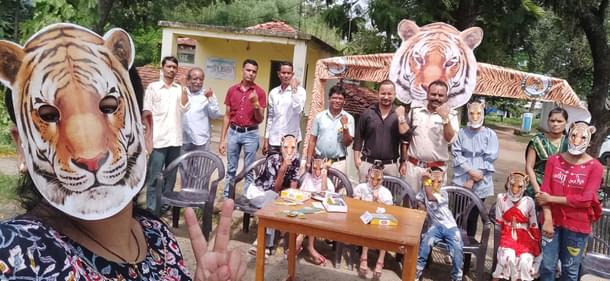States
Clawsome Comeback: Everything Madhya Pradesh Did To Triple Its Tiger Population Since 2010
Nishtha Anushree
Mar 21, 2025, 08:12 PM | Updated 08:12 PM IST
Save & read from anywhere!
Bookmark stories for easy access on any device or the Swarajya app.


On 10 March, Madhya Pradesh (MP) got its ninth Tiger Reserve in the form of Madhav National Park. This solidifies MP's position as the state with the highest number of tiger reserves, followed by Maharashtra with six.
Not only does MP have the most tiger reserves, but it also has the highest number of tigers in the country. As per the 2022 tiger census, 785 of the country's 3,682 tigers were in MP.
It was not an easy journey for the state. When the first tiger survey was conducted in 2006, MP was the state with the highest number of tigers at 300. However, in the 2010 survey, this number came down to 257, putting MP behind Karnataka.
The 2014 survey was worse. Though the tiger numbers rose to 308, the state was behind two states: Karnataka and Uttarakhand. A lot of efforts were needed to regain the 'Tiger State' status.
With a slight change in criteria in the 2018 survey—counting tigers older than one year instead of those above 1.5 years—and extensive efforts, the tiger population in MP rose to 526, restoring its status as the "Tiger State."
However, Karnataka was very close to MP with 524 tigers. Recalling those times, a forest guard in Kanha tiger reserve told Swarajya, "Even with the death of one tiger, we would fear losing the 'Tiger State' status."
In 2022, MP not only solidified its position as 'Tiger State' with 785 tigers, leaving Karnataka far behind at 563 but also paved the way for the opening of new tiger reserves in the state to accommodate the growing number of tigers.
Explaining the almost 50 per cent surge in the tiger population from 2018 to 2022, Deputy Director of Pench Tiger Reserve Rajnish Kumar Singh told Swarajya, "Our management efforts from the 1990s started showing results. Moreover, we deployed forest officers to track tigers in those areas where we suspected tiger population but one that was not recorded."
"MP has a total of 8,200-8,300 forest beats. Of them, in 2014, 732 beats had tigers. In 2018, 1,400 odd forest beats had tigers and in 2022, this number came up to 1,900 odd forest beats due to our efforts of searching for tigers," he explained.
In the last two years, MP has got three new tiger reserves. The first one was notified in September 2023 as Veerangana Durgavati Tiger Reserve in the Damoh and Sagar districts. It had 15 tigers at that time.
After Dr Mohan Yadav became the MP Chief Minister (CM) in December 2023, he decided to further push the wildlife welfare in the state, with a special focus on tiger conservation.
He reconstituted the existing State Wildlife Welfare Board by inducting officers who retired from forest services in March 2024. Its members are appointed for a period of three years.
Speaking on CM Yadav's efforts for wildlife, Kartik Sapre, Chief Executive of Narmada Samagra Nyas, an environmental non-government organisation (NGO) told Swarajya, "Within one year of his tenure, the CM took three meetings of Wildlife Board, which used to happen only once or twice a year."
Building on these and other on-ground efforts, MP got its eighth tiger reserve at Ratapani in December 2024. Located in the Sehore and Raisen districts, the Ratapani tiger reserve is home to 90 tigers.
Notably, the Ratapani tiger reserve got in-principle approval from the National Tiger Conservation Authority (NTCA) in 2008 but the MP government could not notify it due to procedural delays.
This became a major point of criticism for the former CM Shivraj Singh Chouhan and gave him an image of not being 'pro-conservation.'
However, defending Chouhan, IFS (Indian Forest Services) officer Rajnish Singh says: "Not notifying is a different issue, but even without a tiger reserve, the tigers at Ratapani had a good habitat and protection and there were 60 tigers."
"It's not about whether there are tiger reserves or not, it's about whether the management is getting the support or not. Village relocation was most successful in MP among other states and for this, Chouhan allocated up to Rs 1,500 crore," he added.
Singh also believes that tiger conservation has got a new push under CM Yadav and said, "For the first time, our CM is our state Forest Minister."
The continued efforts gave the Chambal region its first tiger reserve and MP its ninth in the form of Madhav National Park in Shivpuri, which was a longstanding demand of the Scindia royal family and the locals.
The Madhav tiger reserve was inaugurated on 10 March, on the birth anniversary of Madhav Rao Scindia, where five tigers, including two tigresses, already existed and an additional pair of a tiger-tigress was introduced in the park.

One of the reasons that delayed the process of the Madhav national park getting the 'tiger reserve' tag is its location in a relatively higher population density area, when compared to other tiger reserves in the state.
For this reason, a 13.5 km-long high boundary wall was constructed at a cost of over Rs 13 crore to avoid interference of the local population with the wildlife. This was also inaugurated by CM Yadav on 10 March.
Explaining it, Dr S R Waghmare, a member of the State Wildlife Board, told Swarajya, "The biggest challenge is that cattle of locals visit the same pasturelands for grazing, which is reserved for the animals. This reduces food availability for animals."
"The habitat of Madhav National Park is not good as there are not multiple sources of water or proper food availability. Habitat development needs to be done and villagers need to be convinced to avoid those grazing grounds," he added.
What MP Did Right
MP not only has abundant natural habitat suitable for tigers but also gained a first-mover advantage by having vast land parcels under protected areas when the Wildlife Protection Act 1972 was enacted.
"Many national parks and sanctuaries were declared in MP after the 1972 Act. This led to the conservation of much of our forest areas and habitat protection for wildlife. No other state has so much protected area," Dr Waghmare explained.
"Tigers need water to drink and animals to feed. We have both due to multiple sources of water and protected habitat. We did well in controlling poaching incidents and providing protection to wildlife, which made us the 'Tiger State'," he added.
However, there was a time in the 2010s when MP was struggling to maintain the 'Tiger State' status. There was no programme or scheme in territorial areas to sensitise the managers or build their capacity for wildlife management and provide them with wherewithal, training or equipment.
This led to incidents where tigers were saved in the breeding areas but lost in areas outside the protected areas. In the 2011-12 state budget, after the 2010 tiger census debacle, a new scheme for 'Protection of Wildlife outside Protected Areas' was introduced.
The scheme empowered the officers and staff in territorial areas with equipment similar to protected areas. The camera traps given to them threw a wealth of information about the presence of diverse wildlife in their areas.
"Barrage of training for staff in relevant areas built their capacity to understand and interpret data and plan management interventions accordingly. They now knew where to concentrate their efforts for wildlife protection. They started taking pride in the management of wildlife in their areas," Jitendra Agrawal, retired Principal Chief Conservator of Forest (PCCF) told Swarajya.
Another challenge was to increase the territories for tigers. For this, the villages within the existing protected areas needed to be relocated, to minimise interference with the wildlife. In 2012, the state government allocated Rs 1,000 crore, an unprecedented, for this task.
The retired PCCF appreciated the field officers for the humane approach during the relocation and said, "Going beyond the call of their duty they provided hand-holding support to people after relocation, even when some of them were relocated outside the state."
The field officers also maintained records well, assisting in the direct benefit transfer to the beneficiaries.
"Between 2010 and 2022, 200 small villages within Tiger Reserves were relocated, with 75 villages moved out of the Satpura Tiger Reserve alone," the MP Public Relations Department said in a press release.

After the relocation, habitat development in these areas was needed. Species such as reindeer, bison, and wild boar from Kanha were translocated to other tiger reserves, thereby enhancing the food base for tigers.
For habitat development, grasslands and ponds were created in the abandoned villages and fields within the forests, boosting the population of herbivores and providing ample food for tigers.
The expert services of Professor Murutkar from Maharashtra were sought. He had expertise in the development of grasslands in relocated villages and other open forest areas. He had a profound understanding of the requirements of different wildlife species and the ecological succession of grasses on different soil types.
"Within months herbivores started thriving in relocation areas. The increase in the carnivore population later was just a natural consequence. They marched long distances in search of new territories. They started re-occupying their lost territories," Jitendra Agrawal shared.
The third step was protection. For this, the MP State Tiger Strike Force (STSF) was activated. It included a core team of competent officers who were trained with the Uttar Pradesh Police Special Task Force (STF), especially for data keeping on criminals.
"They were networked with different State, National, Regional and International agencies and important people therein. Dog squads were strengthened. New dogs were obtained and trained with the help of MP Police and Border Security Force (BSF)," Agrawal added.
In no time, the STSF flourished as a crack team and broke the back of organised poachers. The judiciary was sensitised through a workshop, to ensure conviction in the poaching and wildlife offence cases, further demoralising the poachers.
16 specialised dog teams were formed to detect and investigate wildlife crimes. Over the past eight years, the STSF has apprehended 550 wildlife criminals from 14 states, including three foreigners.
Technology was also used in crime investigation and patrolling to protect wildlife. In Panna Tiger Reserve, drones were utilised for surveying and monitoring, leading to the complete eradication of illegal hunting.
Notably, Panna Tiger Reserve boasts its own drone squad, which operates on a meticulously planned monthly action schedule. This squad aids in locating wild animals, conducting rescues, identifying forest fire sources, assessing the impact of fires, preventing potential human-animal conflicts, and enforcing wildlife protection laws.
How MP Maintains The 'Tiger State' Status
One of the important aspects of keeping wildlife protected is minimising man-animal conflicts. This is being done through awareness programmes in a few areas where villagers are sensitised about the importance of wildlife and the ways to respond in a conflict.
However, a member of the MP Wildlife Welfare Board, Santosh Shukla, expressed displeasure at the fact that despite being made aware, a few villagers enter forests at those times when tigers are active, due to their greed to get some forest materials.
"Earlier, Adivasis (tribals) knew the tiger routine and adjusted their works accordingly. But now, people think of themselves as over smart and ignore our advisories, often putting themselves as well as the wildlife in danger," Shukla told Swarajya.
However, the introduction of timely and generous payments of compensation when a tiger takes one's cattle has resulted in a significant reduction in the mortality of tigers due to poisoning, which was often done by villagers to safeguard their cattle.
"If a tiger eats someone's cattle, compensation is given. This sends a positive message to locals, preventing any grudges against the wild animal," Wildlife Welfare Board Waghmare told Swarajya.
To effectively manage human-wildlife conflict, 16 regional and district-level rescue squads were established across every district. Moreover, each village has an eco-development committee, which coordinates with villagers.
Since 2023, only two humans were killed by tigers in the buffer area of the Pench Tiger Reserve, as a result of awareness efforts of Deputy Director Rajnish Singh, who focuses on minimising human injury as well.
"A bagh chaupal is organised every month in villages where we show educational videos to the villagers, followed by a question and answer session. We are celebrating rakhi as Bagh Raksha Diwas for the last three to four years to give an emotional appeal to the tiger conservation pitch, apart from tourism income," Singh explained.
"Our volunteers tied rakhi to 15,000 villagers last year. This tiger rakhi has a lot of emotional value, which makes villagers feel that tigers are part of their families. The data speaks for itself. The rare occurrences of man-animal conflicts incident show that our strategy is working," Singh elaborated.

However, this initiative has not spread to the entire state and is restricted only to the Pench Tiger Reserve in the Seoni district. Bandhavgarh and Satpura are quickly following up although and Singh is optimistic that his initiatives will find acceptance at other tiger reserves as well.
The rescue and treatment of tigers is also an important aspect of maintaining their population. Rescue of injured or stressed animals including orphaned tiger cubs and their release back into the wild is frequently practiced.
"MP is quite ahead of time. In 2010 itself, the MP Forest Department took 10 veterinary doctors on deputation, probably the first state to do so. Today, MP is the only state that has a cadre of wildlife vets within the forest department," Singh told Swarajya.
"We have vets having 20 to 25 years of experience. We have very good treatment facilities in Bhopal and Mukundpur. At Pench, a good hospital is almost ready. At Jabalpur, there is Centre of Wildlife Forensic and Health, a one-of-its-kind centre in India," he added.
The Scope Of Improvement
Despite a success story, tiger conservation efforts in India fail to get more funds. On the condition of anonymity, an IFS officer told Swarajya, "In 2008, the total NTCA budget was Rs 154 crore. It touched Rs 300 crore in the middle years but again came down to Rs 150 crore in the last year's budget."
As per the data available on the NTCA website, the annual budget was Rs 291.57 crore in 2019-20, Rs 202.4 crore in 2020-21 and 2021-22 and it came down to Rs 168.17 crore in 2022-23.
This presents a worrying picture that in 2008, when the country had only 38 tiger reserves, without buffer areas and in 2025, when the country has 58 tiger reserves including buffer areas, the budget is almost the same and even lesser if the amount is adjusted for inflation.
This means, that on average, tiger reserves have less than even Rs 3 crore for their annual expenditure. While they do get some revenue from tourism, this revenue is further divided with villagers.
"Ultimately, we have to rely only on the Compensatory Afforestation Fund Management and Planning Authority (CAMPA) Fund and Corporate Social Responsibility (CSR) funds for any additional initiatives. The existing funds fulfill only for maintenance works," the IFS officer added.
This also leaves no funds for wildlife research. Earlier, the Wildlife Institute of India (WII) used to do the research but now, it too has become an autonomous body, limiting its research capabilities, the officer explained.
A Wildlife Welfare Board member explained that most of the funds are consumed in habitat development, leaving very little funds for compensation to the villagers, for which the state's exchequer is used.
The IFS officer said that with more funds, the conflicts could be better managed and more expenditure could be done on treatment and rescue of wild animals. Also, more relocation of herbivore animals could be possible with funds ensuring proper food availability to the tigers.
"Vantara has set world-class standards for wildlife rescue and treatment. If Prime Minister Narendra Modi appreciates it so much, then he should think about having similar facilities in more places," another IFS officer said.
The Wildlife Welfare Board member believes that with the availability of helicopters and more cages, the rescue could be quicker. He has proposed the involvement of Non-Governmental Organisations (NGOs) as a force multiplier in rescue efforts.
Another issue creating distress among forest officers is a project allowance of less than even Rs 2,000 per month, while the forest guards receive only Rs 400-500 per month in their difficult postings at tiger reserves, leaving them unmotivated.
While these issues persist, the state has indeed come a long way, more than tripling its target population in 12 years, from 257 in 2010 to 785 in 2022.
Notably, 13 countries had pledged to double their tiger populations by 2022 at the Saint Petersburg Tiger Conference in 2010. While India completed this target, the state of MP went a step ahead by tripling the tiger population.
"Despite everything, there is a scope for improvisation. But when I look back at 10 years ago, we have achieved many things," Pench Deputy Director Rajnish Singh said.
Nishtha Anushree is Senior Sub-editor at Swarajya. She tweets at @nishthaanushree.





